
A synagogue, sometimes referred to by the Yiddish term shul and referred to by Reform communities as a temple, is a Jewish house of worship. Synagogues have a place for prayer, where Jews attend religious services or special ceremonies, have rooms for study, social hall(s), administrative and charitable offices, classrooms for religious school and Hebrew school, sometimes Jewish preschools, and often have many places to sit and congregate; display commemorative, historic, or modern artwork throughout; and sometimes have items of some Jewish historical significance or history about the synagogue itself on display.
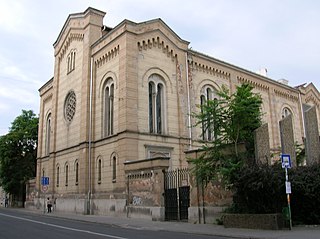
The Kazinczy Street Synagogue of Miskolc is the only surviving synagogue in the city of Miskolc, Hungary, and the only still functioning synagogue of Borsod-Abaúj-Zemplén county.

Congregation Beth Elohim, also known as the Garfield Temple and the Eighth Avenue Temple, is a Reform Jewish congregation located at 274 Garfield Place and Eighth Avenue, in the Park Slope neighborhood of Brooklyn in New York City, United States.

The Dohány Street Synagogue, also known as the Great Synagogue or Tabakgasse Synagogue, is a historical building on Dohány Street in Erzsébetváros, the 7th district of Budapest, Hungary. It is the largest synagogue in Europe, seating 3,000 people and is a centre of Neolog Judaism.
David Feuerwerker was a French Jewish rabbi and professor of Jewish history who was effective in the resistance to German occupation the Second World War. He was completely unsuspected until six months before the war ended, when he fled to Switzerland and his wife and baby went underground in France. The French government cited him for his bravery with several awards. After the war, he and his wife re-established the Jewish community of Lyon. He settled in Paris, teaching at the Sorbonne. In 1966, he and his family, grown to six children, moved to Montreal, where he developed a department of Jewish studies at the University of Montreal.
Temple Beth Israel was a Reform synagogue located at 840 Highland Road in Sharon, Pennsylvania. Originally called House of Israel Congregation, it was founded in 1888 as an Orthodox congregation by Jews from Eastern Europe.
The Rue Édouard-Herriot is one of the most important shopping streets of the Presqu'île in Lyon. It links the two most famous places of the city, the Place Bellecour (south) and the Place des Terreaux (north). Its northern part is located in the 1st arrondissement of Lyon, but the main part of the street is in the 2nd arrondissement. In its southern part, the street passes through the Place des Jacobins. It belongs to the zone classified as World Heritage Site by UNESCO.
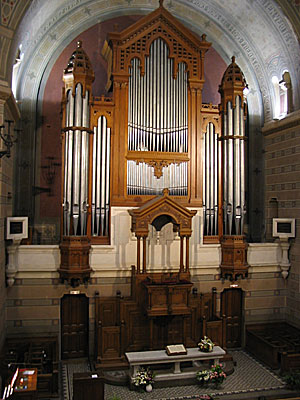
The Grand Temple de Lyon is a Protestant church located at No.3 Quai Victor Augagneur, in the 3rd arrondissement of Lyon.
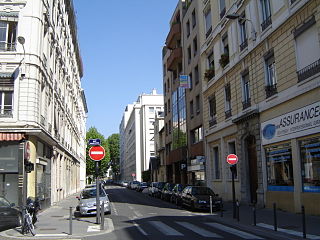
The Rue Tronchet is a street located in the 6th arrondissement of Lyon, named after French jurist François Denis Tronchet (1726–1804).
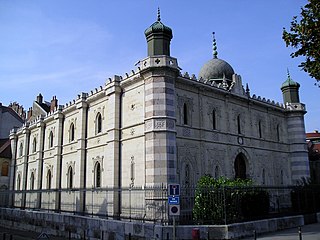
The beginnings of the history of the Jews in Besançon go back to the Middle Ages, a period during which the Jews settled in the city attracted by its activity as a commercial place. The community was founded at the end of the 14th century and, due to its status as a free imperial city, Besançon remained one of the only territories in present-day France to tolerate Jews after their expulsion from the kingdom of France in 1394. The community was nevertheless expelled in turn from Besançon in the middle of the 15th century. The Jews made a tentative return to the city in the 18th century, but it was only after the French Revolution, which emancipated them, that their situation in the Franche-Comté capital stabilized. Although the Jewish community never exceeded 2,000 people except on the eve of the Second World War, it experienced great economic success during the industrial revolution at the end of the 19th century, when the Lipmann family founded LIP, a brand of watchmaking which then became one of the economic engines of the region and remained associated with the name of the city.
Atara Marmor was a French historian and art collector.

The Synagogue de Nazareth is situated on the Rue Notre-Dame-de-Nazareth, in the 3rd arrondissement of Paris, and is the oldest of the 'great' synagogues of Paris. It is normally known as Synagogue Nazareth rather than Synagogue de la rue Nazareth, its official name.
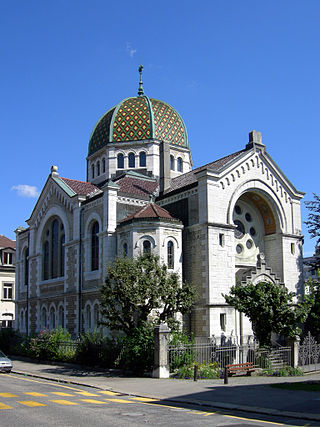
The synagogue of La Chaux-de-Fonds is a synagogue located at 53 Rue du Parc in La Chaux-de-Fonds, canton of Neuchâtel, Switzerland. It was opened in 1896 and was listed among the Cultural Property of National Significance. It is also part of the La Chaux-de-Fonds 19th-century urban ensemble listed as a World Heritage Site.

The Synagogue of Amiens is a Jewish Synagogue in the city of Amiens in the Department of Somme, France. The synagogue, rededicated in 2017, replaces two previous buildings.
The Israelite Seminary of France also known as the Central Rabbinical School of France , is a Rabbinical school that trains Orthodox rabbis in France. Founded in Metz in 1829 as the Central Rabbinical School of Metz, it moved to Paris in 1859, where it is based in the city's 5th arrondissement. The school is connected with the Israelite Central Consistory of France, one of the major bodies of Orthodox Judaism in France.

The Saint-Avold Synagogue is a Jewish synagogue at the corner of Rue des Americains and Rue de la Mertzelle near Place Paul-Collin in Saint-Avold, France. The current synagogue building, completed in 1956, replaces a nearby synagogue destroyed during the German occupation of France in World War II.
Keren Or Synagogue is a Reform Jewish Synagogue which serves as the synagogue for the Liberal Jewish Community of Lyon. It is located at 15 Rue Jules Vallès in Villeurbanne.

The Synagogue of Arcachon is a Jewish synagogue located at 36 Avenue Gambetta in Arcachon, Nouvelle-Aquitaine, France.

The Great Synagogue of Marseille is a synagogue on Rue Breteuil in the 6th arrondissement of Marseille. It is classed as a monument historique since 2007.

The Rashi Synagogue is a Jewish Synagogue on 5 rue Brunneval in Troyes, Grand Est, France. The synagogue is named after the medieval Jewish Rabbi and biblical commentator Rashi, who was born and died in Troyes. A Sephardic Orthodox synagogue, it is a member of the Consistoire central israélite de France. The site includes a museum, the Rashi House, a cultural center, and a library. The European University Rashi Institute,, located opposite the synagogue, is a research institute independent of the synagogue focused on Jewish studies, Semitic studies, and Monotheism.
























